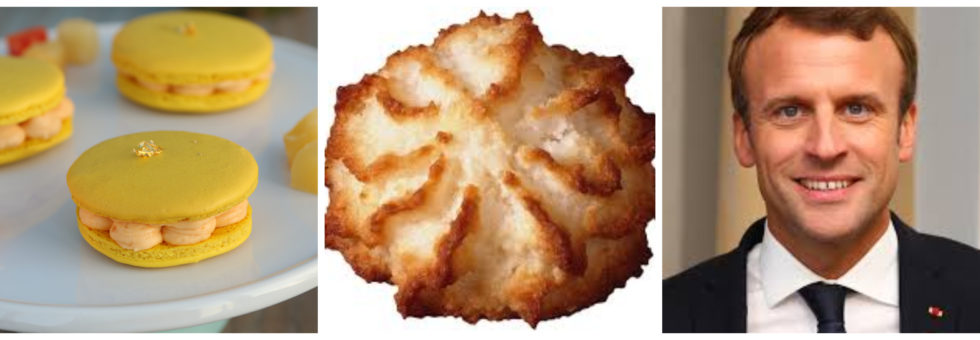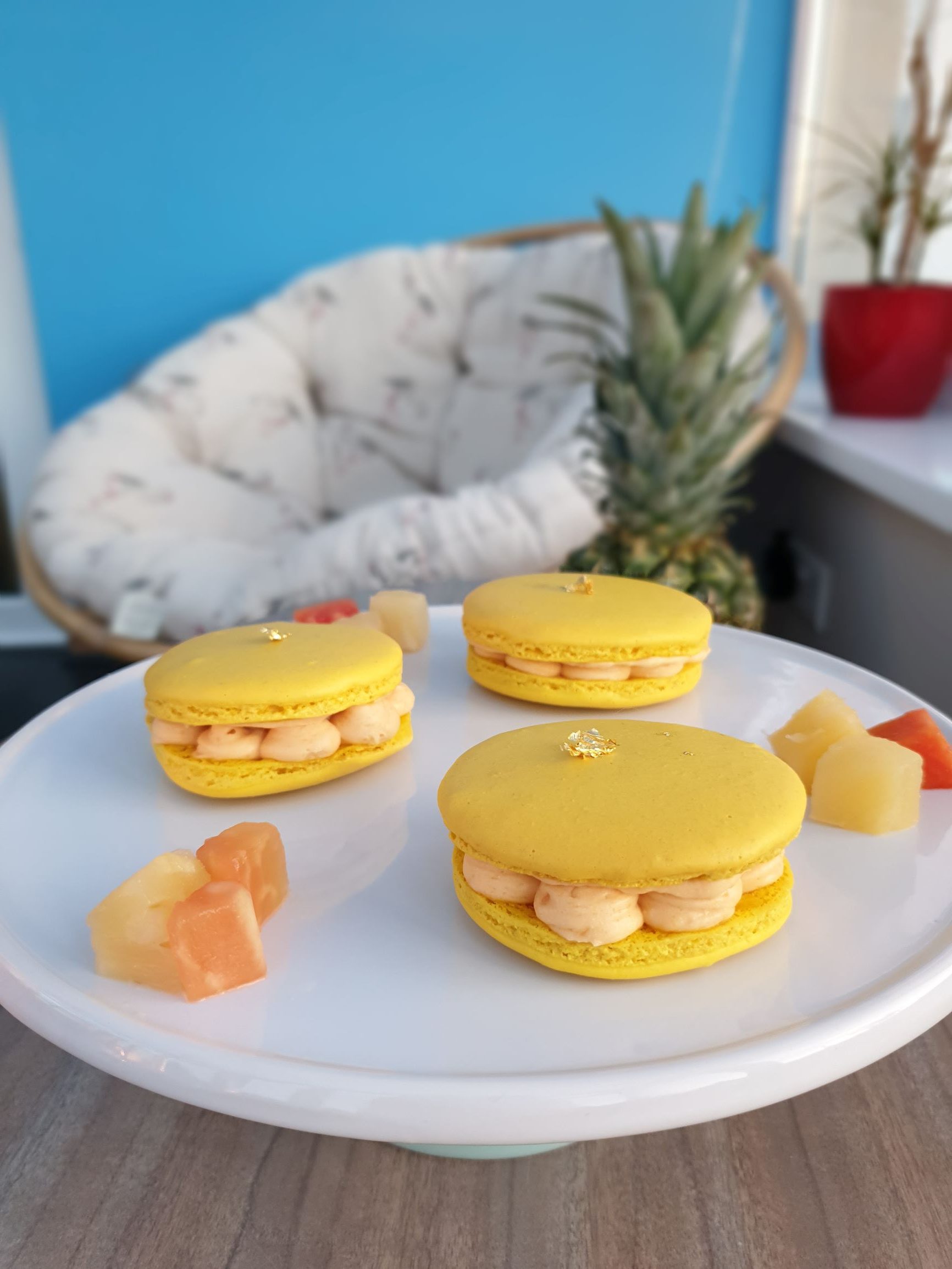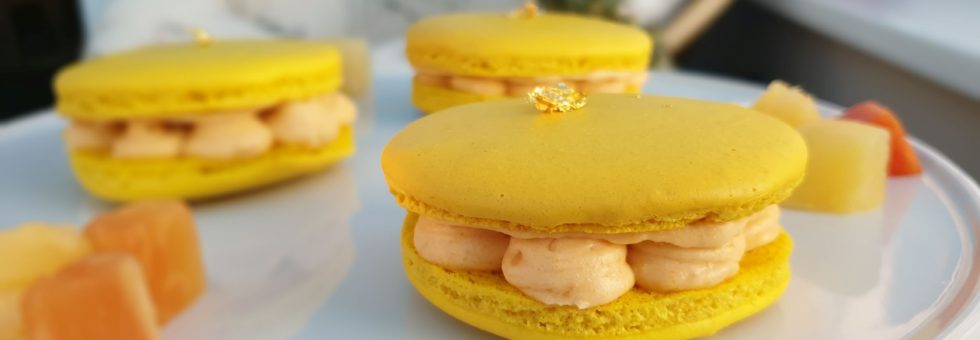This isn’t my first macaron rodeo. My husband and I made them as part of our wedding cake table, so a few years ago we were seasoned macaroneers. However, I hadn’t made them since and wanted to revisit the delicacy with a twist. When choosing a recipe I had 3 key criteria:
- It should make larger macarons than usual, either dessert size ones, or one giant one;
- I was keen to try a crème diplomat filling;
- It needed to use an Italian meringue, instead of a French one.
There were plenty of appetising recipes for giant raspberry macarons, but having recently made raspberry millefeuille, I felt it was time for a change of fruit. So I opted for [literal translation] “large exotic fruit macarons”. Well they do sound exciting! While “exotic” does conjure up vibrant images of a carnival in your mouth, I decided that “tropical” would be a more appropriate description, while conveying all the excitement of exotic fruit.
My recipe bakes the ground almonds first to add depth of flavour, which I hadn’t come across before. The filling consists of a tropical fruit crème diplomat with both caramelised and fresh pineapple in the centre.
Macaron or macaroon?
Let’s address the elephant in the macaroom.
Macaron is often used interchangeably with macaroon, or spelt “macaron” but still pronounced macaroon. However, they are two entirely different sweet treats. A macaroon is a coconut-based snack (known in French as a “rocher” due to it’s irregular rock-like shape or “congolais”) whereas a macaron is two almond meringue shells sealed with a filling. And Macron is the President of France.
I’m glad we’ve set that straight and can all move on with our lives.

Meringue
A little background on meringue. There are 3 main types: French, Italian and Swiss.
- French meringue is made by mixing together egg whites and sugar at room temperature.
- Italian meringue involves heating a sugar syrup and adding it to the whisked egg whites.
- Swiss meringue goes the whole hog and invites you to heat and whisk the sugar and egg whites over a pan of simmering water.
Swiss meringue is considered to produce the most stable meringue, but I have not come across it being used in many macaron recipes, unless I specifically search for it. I have seen it used more often for Swiss meringue buttercreams, producing a very silky cake topping. French and Italian meringues seem to be the most popular for macarons. I don’t have anything against the French method, but it hasn’t always worked out for me, whereas the Italian method has worked fine. There are a lot of things that can go wrong when making macarons, one of which is the sugar not properly being incorporated into the egg whites, causing them to crack during cooking. Heating the sugar makes it easier to be absorbed, thus eliminating one of the many risks of macaron-making.
Translation
Crème diplomate or Diplomat cream?
My recipe calls for a tropical fruit “crème diplomate” filling, which is made by mixing crème patissière with whipped cream, thereby producing a much lighter cream. I was in two minds as to whether to leave it in the original French or translate the term. I’ve heard the French used fairly often, including on the Great British Bake Off, so I decided not to translate it. However, when I researched deeper into the English usage, I noticed that the spelling in English is “crème diplomat”, with the ‘e’ omitted from diplomate. It feels uncomfortable using the French words for a term and spelling it incorrectly (the ‘e’ is used to make the adjective “diplomat” agree with the feminine “crème”), yet this is the accepted spelling in English recipes.
Culinary creativity
In the introduction the author states: « la coque du macaron sert de support à votre créativité », literally: the shell serves to support your creativity. A lovely concept, but it doesn’t sound quite as eloquent in the English. As a translator I need to think about the message the writer is trying to convey and make it sound appropriate in English. What they actually mean is that the macaron shell is a blank canvas for you to work with to explore different flavours and designs.
Acidic flavours
The filling is described as a “garniture acide”, i.e. acidic, which sounds a little scientific and unattractive for a macaron recipe, so I opted to render it as “sharp” which has more positive connotations.
Gelatin
As part of the crème diplomat I needed to “réhydrater la gelatine”, literally: rehydrate the gelatin. However, English recipes speak of “blooming” the gelatin. This involves submerging it in water for a few minutes to absorb the liquid and enlarge, i.e. bloom. Only then is it ready to use and will help form a smooth texture. Here, the gelatin is used to help set the crème diplomat.
Le tant pour tant
The almond and icing sugar mixture is referred to as the “tant pour tant”, literally “so much for so much”. This phrase is sometimes used in recipes as a noun to mean equal measures of some ingredients, in this case the icing sugar and ground almonds. I decided to refer to this as the “almond mixture” as the recipe clearly explains that icing sugar is also included.
Le Macaronage
The French love inventing words and my new favourite is “macaronage”. It refers to the stage in the macaron-making process when the almond mixture is combined with the meringue. A careful folding process is required to achieve the right consistency: not too solid and not too runny. The recipe recommends running the spatula round the inside of the bowl before cutting through the centre. The idea is to combine the ingredients and create a smooth enough texture to pipe without leaving peaks, yet not so runny the macarons don’t hold their shape. One way of testing whether it is ready is to see whether a ribbon of the mixture melts back in after 10 to 15 seconds. If it doesn’t, more folding is required, if it disappears too quickly then it is already too runny and, as my recipe brutally points out, is a “lost cause”!

Overall
I actually burnt my first batch of macaron shells after repeatedly allowing them another few minutes to set. They were possibly too runny anyway, so I just remade them the following day and it was a good opportunity to get a better feel for the right consistency. It was refreshing to experience tropical flavours in a macaron, as opposed to the usual run-of-the-mill ones and the caramelised pineapple filling was a delight.
Next week I’ll be cooking up a savoury Spanish seafood dish….



